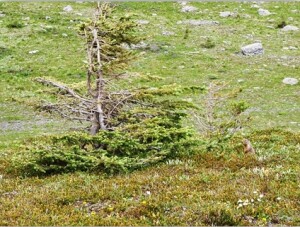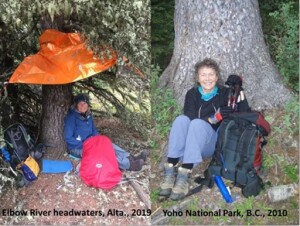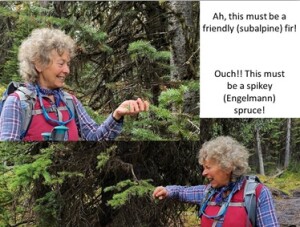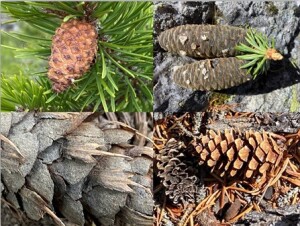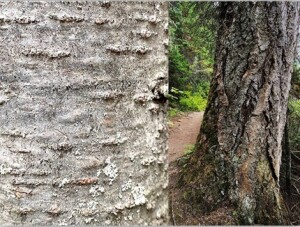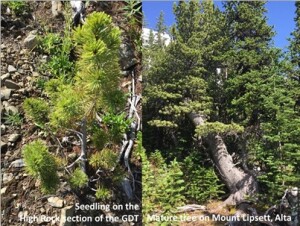By Jenny L. Feick, PhD
Unless noted otherwise, all photographs in this article were taken by the author or Ian Hatter in the Canadian Rocky Mountains.
Is it a pine? Is it a fir? Is it a spruce? And why should I care?
Most people hike through the coniferous forests along the Great Divide Trail without giving much thought to the trees unless they are clambering under or over trunks that have fallen across the trail, or on a Great Divide Trail Association work party removing deadfall and pruning branches. However, it is worthwhile knowing what species you will encounter as you hike and/or work on the GDT and their characteristics, both the pros and the cons.
Big Picture Pros and Cons – To Breathe or not to Breathe
First off, you should know that hiking through natural coniferous forests confers many health benefits and is one of the best things you can do for your physical and mental wellbeing. Conifers exude substances called phytoncides (wood essential oils), which are antimicrobial volatile organic compounds such as α-pinene (pine scent) and limonene (lemon scent). Breathing in these substances helps boost the immune system in human beings and stave off depression and anxiety. Each time I return to the Rockies and inhale its characteristic subalpine fir forest fragrance, it immediately puts me in a good mood. So, appreciate the health benefits you are getting from just breathing in the characteristic fragrances of pine, spruce and fir as you meander through the montane valleys and slog up steep subalpine slopes. Hiking the forested sections of the GDT is the ultimate in forest bathing or “Shinrinyoku” in Japanese.

Hiking through the subalpine forests along the GDT is one of the best things you can do for your health. Ian Hatter at North Kananaskis Pass, August 2011.
Unfortunately, when coniferous forests burn, the resulting wildfire smoke contains very small particles that travel deep into your lungs when you inhale. These particles can cause irritation and inflammation that last until the air quality improves. So, hikers need to be careful not to exert themselves during periods when forest fire smoke blankets the mountains. People with heart and lung disease risk worsening their condition. Even in aerobically fit individuals, wildfire smoke may result in sore throat, irritated eyes, runny nose, mild cough, phlegm production, wheezy breathing, and headaches. It is better to take a rest day. Plus, when it’s smoky, you miss all the great views along the GDT!
What is a Conifer Anyway?
The word “conifer” literally means “cone bearer”. Coniferous trees and shrubs are Gymnosperms since they are woody plants that reproduce by forming a cone to contain seeds rather than reproducing via a flower that becomes fruit. All modern conifers evolved from one now-extinct family of conifers during the Mesozoic Era over 200 million years ago, around the time of the rise of the dinosaurs. The conifers discussed in this article are all members of the Pine Family (Pinus).
While most conifers are evergreen, the term “evergreen tree” is not synonymous with “coniferous tree”. The term evergreen describes a tree’s leaves. Unlike a deciduous tree that drops its leaves in the autumn, an evergreen tree keeps its leaves all year long. In the case of evergreen conifers, their leaves are needles. Each December in North America and Europe, many pines, spruce, and fir “Christmas trees” end up in living rooms with presents under them.
Just to be Different
All conifers produce cones but not all evergreens produce cones. Evergreen trees that are not conifers (broad-leaved flower-producing evergreens) flourish in the tropics. Deciduous conifers exist as well and can even be seen along the GDT. The “larch madness” that afflicts hikers in the Rockies each autumn derives from people’s fascination with the needles of the coniferous subalpine larch turning gold before the tree sheds them. You can read more about this fascinating tree in The Lovely Larch – Coolest Tree on the GDT from the October 30, 2020 issue of The GDTA’s Pathfinder Newsletter.
What are you looking at?
The subalpine larch is fairly easy to tell apart from the other coniferous trees you might see along the GDT, especially in its autumn gold or dormant winter state. So, let’s focus on the most common evergreen conifers that you will see when hiking the GDT. These include the pines (lodgepole and white-bark), the spruces (white and Englemann), the subalpine fir, and the Douglas-fir. There are a few dry places where you may see Rocky Mountain juniper and moister valleys like the Blaeberry in BC where Pacific yew, Western red cedar, Western white pine and Western hemlock grow. However, learning more about these species will have to wait for another article.
Is it a pine? Is it a spruce? Is it a fir?
Discerning Clues from your Location
Sometimes people make the assumption that every cone is a pine cone and thus all the trees they see are pines. Along many parts of the GDT where forest fires prevailed in the past, lodgepole pine still dominates many forests. However, if you look closely, you will see other trees growing in the shade of those pines, including white spruce. In certain drier areas you may also see Douglas-fir rising above the pines. Don’t be fooled; the Douglas-fir is not a true fir. It is a unique type of conifer in its own genus[1]. Along the GDT, you have to ascend to higher elevations (600 to 2,250 metres asl[2]) to see a true fir, the subalpine fir. In snow-dominated forests below the treeline, the spruce you see is the Engelmann spruce. On the high rocky windswept ridges, lodgepole pine gives way to whitebark pine, Canada’s only endangered tree species protected by federal species-at-risk legislation. In western Canada, whitebark pine occurs in a diversity of forested ecosystems, predominantly in the upper montane and subalpine from the Canada-US border to its northern extremity near the continental divide at Kakwa Wildland Interprovincial Park. Usually found around 2400 metres above sea level (asl) in the vicinity of the GDT, the low-elevation extent of the species’ range is around 1700 metres asl.
Searching for Growth Patterns
The overall appearance of a conifer and the way its branches grow provide reasonably good guidance on its identity. Most conifers have strong apical dominance, meaning that the terminal bud (usually, the highest growing tip on the plant) produces indole acetic acid (IAA), a growth substance that inhibits development of apical dominance on any of the lower branches. This is why most conifers have a single erect trunk with a single live top and why it is extremely difficult to use the cuttings from branches of most conifer species to grow trees. However, there is an exception to this trend with significant consequences for GDTA trail work volunteers and GDT hikers.
Unlike most conifer species, subalpine fir has weak apical dominance. This species will commonly develop multiple points of apical dominance, usually in one of two situations:
- an injury to the growing tip stops IAA production and more than one secondary growing tip independently assumes dominance;
- a lower branch grows toward the ground and roots (a process called layering), after which the rooted branch assumes apical dominance independent of its mother tree.
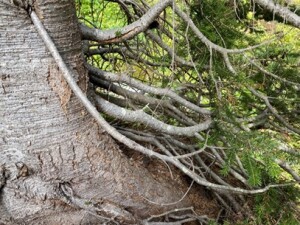
Subalpine fir branches grow toward the ground where they root and form new trees through layering, a form of vegetative reproduction.
This tendency toward layering allows subalpine fir to reproduce in situations where the growing season is too short for normal cone and seed maturation to occur, most notably in high altitude settings like near the Great Divide. As a result, GDTA work parties can spend many days clearing parts of the GDT lined with subalpine fir whose lower branches have rooted and developed into individual saplings. Removing all of the lower branches and emerging saplings within the clearing zone is a labourious, detail-oriented, and time-consuming task. However, GDT hikers greatly appreciate this pruning and branch removal work since bushwhack backpacking through dense stands of subalpine fir with rooted branches is akin to swimming through molasses.
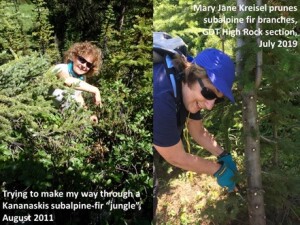
Hikers who have bushwhacked through dense subalpine fir stands really appreciate the pruning efforts of GDTA trail work volunteers!
Looking upward, the subalpine fir displays a distinctive tall, narrow conical crown of short stiff branches that help it shed snow in the winter. The crowns can appear somewhat flattened and irregular in older trees. A medium-sized tree usually grows to 20 to 35 metres tall, but occasionally reaches 50 metres in height with a 200 cm d.b.h.[3] Along the GDT, it’s often much smaller due to the harsh environment and occurs as krummholz[4] at high elevations.
The branches of the straight-trunked conical shaped Engelmann spruce also point down to shed snow, allowing this species to grow at higher elevations than the shorter somewhat stockier white spruce. Engelmann spruce is a medium- to large-sized tree species that grows to 50 metres tall, ten metres shorter than the typical white spruce. Both species can attain one metre d.b.h. Engelmann spruce branches near the ground tend to droop, but fortunately for GDTA volunteer trail builders, do not take root. White spruce have fairly even conical crowns and numerous, densely foliated branches that extend toward or even reach right to the ground. During a sudden rainstorm, taking cover under a mature white spruce along the GDT has helped many a hiker stay dry.
Lodgepole pine typically has a long, slender, pole-like trunk[5] with a short, narrow, cone shaped crown. In the vicinity of the GDT, lodgepole is best known as a tall, slender tree, growing in forests composed exclusively of even-aged, tapering trees of this single species, and whose skinny trunks are free of limbs. Lodgepole reaches a typical height of 70 to 80 feet (21 to 24 m) but usually is less than 15 inches (38 cm) d.b.h. in the southern Rockies.
Less well known is the lodgepole’s ability to assume very different forms from the typical spindly, skinny ‘dog-hair’[6] variety. Single lodgepole pines mixed with other conifers may retain the typical height, developing a thicker trunk reaching a foot or more d.b.h. If conditions are right, it may even keep full foliage right to the ground, although usually lower branches die and remain on the tree. Or it could boast a robust trunk, branching into several equal-sized central stems near the ground, replete with needles from the ground up, and be almost as broad as it is tall. Forms intermediate between the two extremes exist and different forms may be found close by, depending on the available space and light. The short thick form requires full sun for many hours each day, with no other trees crowding it, and above average moisture for the roots. The tall slender form with green branches just near the top is by far the most common one seen along the GDT. However, on ridgetops, from a distance, lodgepole can look as gnarly as a whitebark pine, and you must get closer to verify its identity.

Pine Shape Quiz: Can you tell which tree is the lodgepole pine and which one is the whitebark pine? (Answer at the end)
Speaking of whitebark pine, this subalpine tree also varies in shape. In more favorable conditions, it can develop into a small tree 29 meters (95 ft) in height with a rapidly spreading trunk and broad crown. Or on high alpine ridgetops, it can assume the contorted shape of a krummholtz shrub with a wide-spreading crown and twisted, gnarled branches when exposed to strong winds.
In contrast, the majestic Interior Douglas-fir has a pyramidal shape with an open upright stature. Its lower branches droop and its upper branches point upward. Its lush needles form a beautiful, seemingly downward sweeping canopy. On hot summer days in the vicinity of the Crowsnest Pass, wise hikers seek the shade of these noble giants during their lunch or snack breaks. Mature Douglas-fir (200-300 years old) typically reach an average height of 30 to 37 m (100 to 120 ft) with a d.b.h. between 38 and 102 cm (15 and 40 in). On the best sites, dominant trees may attain a height of 49 m (160 ft) and a d.b.h. of 152 cm (60 in).
Feel your way to your Answer
One of the best ways to tell a spruce from other trees is by using your sense of touch. If you grab a spruce branch, you will likely say, “Ouch!” The individual needles that emerge from spruce tree branches feel stiff and pointy with sharp edges. You can easily roll the narrow needles between your fingertips. Spruce needles are spiny and sharp.
By comparison, if you grab onto the branch of a pine or a subalpine fir, it won’t hurt your hand. While fir tree needles also grow individually on their branches, the needles are soft, flat and fat. They don’t roll between your fingertips. Fir trees are thus much nicer to grab onto when bushwhacking.
So, you can use two mnemonics to differentiate between spruce and fir: “spikey spruce” and “friendly fir”.
One caution: the needles on Douglas-firs can be confused with those of true firs because their needles are flexible and thus also soft to touch. However, Douglas-fir needles are spirally arranged on the branch, and due to twisting at the base of each needle they can appear flattened in two rows, a pattern not seen in the needles of the other common conifer species.
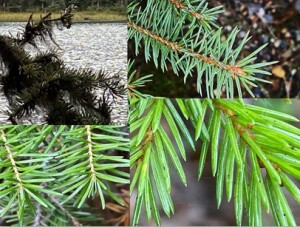
Needle Know-How, Part 1: Looking at these conifer needles, what species are you looking at? (Answers at the end)
Pines are also softer to touch than spruce trees, but their needles tend to be much longer than spruce needles and arranged in distinct clusters instead of individually on a branch like the spruce or the fir. Those clusters hold the key to distinguishing the common lodgepole pine from the endangered whitebark pine. If the needles are in groups of two, you are looking at a lodgepole. If the needles are in groups of five, it’s a whitebark.
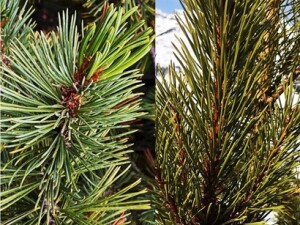
Needle Know-How, Part 2: Based on the needles, can you figure out which tree is the endangered whitebark pine and which one is the common lodgepole pine? (Answer at the end)
If you are working on clearing the GDT, differentiating whitebark from lodgepole pine is the most important conifer ID fact you need to know. Every whitebark pine tree, no matter its age or condition, is protected by law, so you cannot cut them or harm them in any way. If you do, not only are you are in violation of the Species at Risk Act and regulations, you risk jeopardizing the positive reputation and future work permits of the GDTA. Remember the mnemonic, “Needles in groups of five, keep it alive. Needles in groups of two, I can cut/prune you.”
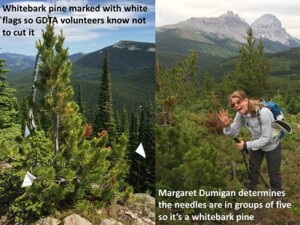
GDTA trail work volunteers must check to see if a pine has needles in groups of two or five. If the latter it is an endangered whitebark pine and must be left alone.
Clues in the Cones
Conifer female or seed cones (as opposed to male pollen cones) vary with the type of conifer (spruce, fir, Douglas-fir, pine) and by individual species. As you wander through the forest, if you can see the seed cones on the conifer tree you are wondering about, they will help you identify it. Spruce and pine cones hang down from the top of the tree. Subalpine fir cones point upwards and display an interesting purplish colour.
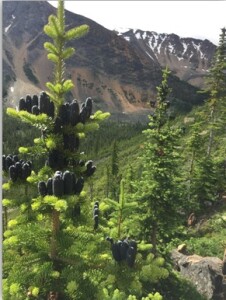
Most cones hang down but subalpine fir cones point up. Tonquin Valley, Jasper National Park, Alta. July
Douglas-fir cones are unmistakable. They are the only ones you will find along the GDT (and in fact, in the entire Pacific Northwest) displaying distinct, three-pointed bracts sticking out of the scales. Unlike the true firs, Douglas-fir cones hang down rather than standing up on the branch. Also, unlike the true firs, the Douglas-fir drops its cones to the ground intact. If you see these unique cones on the ground, that’s your clue that you know there is a Douglas-fir nearby. The appearance of these cones led to fascinating Indigenous stories[7] about the origin of this species. Subalpine larch seed cones also have bracts that are much longer than the cone scales but the trees are so different looking and grow in such different habitats in the vicinity of the GDT, that it is highly unlikely that one would have trouble distinguishing them. Subalpine larch seed cones are also considerably smaller than Douglas-fir cones.
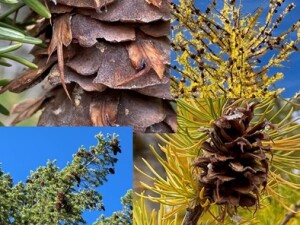
Douglas-fir cones (left) and subalpine larch cones (right) both have mouse-tail shaped bracts but larch cones are much smaller
The cones of pine trees vary with the species. The roughly egg-shaped cones of lodgepole pines are light brown, approximately one to three inches (three to seven cm) long and have sharp prickles on their scales. Whitebark pine have similarly sized (three to eight cm) egg-shaped to almost round cones that grow at right angles to the branch with scales growing in roughly five spiral rows.
To complicate things, lodgepole pines produce two different types of seed cones (closed or serotinous and open or non-serotinous). The serotinous[8] cones often remain tightly sealed and on the tree until exposed to fire when they open. Serotinous cones require temperatures of 113 to 120 degrees Fahrenheit (45-50 degrees C) to melt the resin that binds the scales of the cone, temperatures that generally accompany moderate to severe fire, so they can open and release seed. These cones are well insulated with resin to survive brief periods in flames. Individual pine trees predominantly bear either open or closed cones, and most mature Rocky Mountain lodgepole pine stands contain trees that have both types of cones Though Rocky Mountain lodgepole pine may start bearing cones at less than 10 years of age, serotiny is usually not expressed until trees are 30 to 60 years old.

Hedging its bets, this 15-year old lodgepole pine near the divide in Kootenay National Park produced one of both types of cones, open (left) and closed (right).
In contrast, all whitebark pines cones stay permanently closed and the wingless seeds are released only when the cones fall to the ground and decay or when animals pry open the cones seeking the large (about the size of a pea) seeds. Several wildlife species rely on these high-fat, calorie dense, protein-rich seeds as a vital food source, most notably the Clark’s nutcracker, but also the red squirrel, plus grizzly and black bears. Clark’s nutcrackers use their long, pointed beaks to break apart the large cones and remove the seeds. The birds cache the seeds just under the soil surface at lower elevations and often at above ground locations at higher elevations to ensure a reliable source of food for winter. They use adjacent rock and wood debris to create triangulated memory maps that assist them in relocating the seeds when needed. An individual nutcracker may cache up to 98,000 seeds in a year, as far as 30 km away from the source tree! Roughly half the seeds cached are not retrieved for various reasons and many of these germinate and grow into pine seedlings.
The seeds of Rocky Mountain lodgepole pine are small, winged and thus disperse easily with wind. Rocky Mountain lodgepole pine has two modes of seed dispersal, based on cone serotiny. In Rocky Mountain lodgepole pine stands with predominantly serotinous or closed cones, the most important method of dispersal remains the releasing and scattering of seed on the forest floor after fire opens the cones. This leads to the development of extensive even-aged lodgepole pine stands so prevalent along much of the GDT. The non-serotinous or open cones allow seed release to occur at various times, creating lodgepole pine forests of varied ages and often mixed with other tree species.
Using seed cones to identify spruce species is another matter altogether. White spruce seed cones are light brown to purplish and hang from the upper branches. The seed scales have a smooth, rounded outer edge. Engelmann spruce seed cones are slender, cylindrical, yellow to purplish brown and pendulous, hanging from the upper branches. Their papery-thin, flexible seed scales are tapered at both ends and have a ragged or wavy outer edge. White spruce cones are smaller than Engelmann spruce cones[9]. However, although pure Engelmann spruce cones and pure white spruce seed cones look different, these tree species hybridize and that can affect seed cone size and appearance. If you happen to see the male pollen cones, the white spruce pollen cones are pale red whereas Engelmann spruce pollen cones look yellow to purplish-brown.
Barking up the Wrong Tree?
The bark of the conifer trees along the GDT tends to be less helpful in identifying species except in a few cases. Subalpine fir has characteristic silver grey bark with distinct resin blisters. Older Douglas-fir trees have thick insulating bark, an adaptation to help the tree resist light intensity forest fires. Mature sub-alpine larch trees also possess thick fire-resistant bark.
Ironically, the whitebark pine’s bark doesn’t really look white, except when very young and smooth when it is sort of a greyish chalky-white colour. As the tree ages, the bark becomes tan or brown and breaks into narrow scaly plates one or two cm thick.
In terms of the easiest tree trunks to blaze, GDTA blazing expert Dave Higgins says he prefers the subalpine fir. “Next might be whitebark pine, if it weren’t for its protected status. Both these trees have bark that needs no scraping and one application of paint adheres very well for a long time. [Subalpine] Larch has to be scraped and usually needs two paint applications with drying time in between. The bark of spruce is similar, and both these are less than ideal because the bark continues to grow and flake off over time. Lodgepole pine would be 2nd from last on the list as they’re more likely to have a short remaining life if they’re large enough to blaze in the first place. Dead last would be [non-conifers] aspen or poplar due to their tendency to die seemingly at random.” Dave doesn’t mention Douglas-fir but they would likely be similar to spruce. They are harder to blaze as they age and develop deeply furrowed bark.
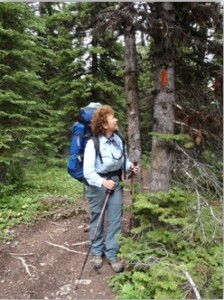
The author gazing at a GDT blaze on the trunk of a subalpine fir tree, Oldman headwaters, August 2010).
Common English Names Only Part of the Story
Of course, the names used so far in this article are not what the various Indigenous peoples along the GDT route[10] called them. Indigenous people made use of various conifers and like other aspects of the natural world respected them as relations with whom they were connected physically and spiritually.
Many First Nations had names in their own native language for various types of conifers although a one-to-one match between the Indigenous names and the scientific species names does not always exist. For example, the Secwepemc referred to what we call subalpine fir as melénłp, məlénłp, menenpéłp (all ‘medicine plant’) whereas the Ktunaxa called it nisnap, nisnapułał or t’isłúłał. First Nations utilized the nutritious seeds of the whitebark pine. The Secwepemc called the edible seeds stsek’ and the tree stsek’éłp (cf. estsek’ “squirrel” + -ełp “plant”). The Ktunaxa words were q’anłat’ana and q’anłat’anał. Known as apahtó’kii by the Káínai Nation of the Blackfoot Confederacy, lodgepole pine held significance for the culture of the Blackfoot people in a variety of ways, as it did for other First Nations. The Secwepemc called the tree itself qw liʔt or qw eqw líʔt (plural) and had names for the edible inner bark (stiʔqw ’əl’q) and the outer bark (p’əlen). The Ktunaxa called the tree ʔiłtit’ and the edible inner bark ʔaknaq.
Scientists use a binomial nomenclature system based on Latin for conifer and other organisms so no matter what language they speak they can communicate with one another about a particular species. Scientific names identify the genus and the species. The species name describes some aspect of the species (e.g., Pinus albicaulis means a white-stemmed pine), or commemorate a scientist (e.g., Picea engelmannii is named for George Engelmann (1809-1884), the botanist who first described the species for science). The common English and scientific names for the primary conifer species along the GDT appears in the following table.
| Common Name
(English) |
Scientific name
(Genus species, subspecies or variety) |
| lodgepole pine | Pinus contorta, var latifolia |
| whitebark pine | Pinus albicaulis |
| subalpine fir | Abies lasiocarpa |
| Engelmann spruce | Picea engelmannii |
| white spruce | Picea glauca |
| subalpine larch | Larix lyallii |
| Douglas-fir | Pseudotsuga menziesii subsp. glauca |
The use of names for things helps communities of people (be they a First Nation, the western scientific community, or GDT hikers) recognize things in a similar way so they can meaningfully communicate with one another.
Tree ID as a Mindfulness Practice
Besides providing practical information of benefit to a hiker or GDTA volunteer trail builder, learning to recognize the various conifer identities can serve as a mindfulness practice. While not as all-encompassing or immersive as “Shinrinyoku” (forest bathing), nevertheless it facilitates slowing down, being present, and using one’s senses, things that improve one’s mental and physical wellbeing, something we should all care about.
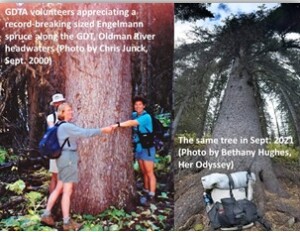
Where coniferous forests have not been logged, tree appreciation along the GDT continues for decades.
Answers:
Pine Shape Quiz: That straight-trunked tree on the subalpine ridge is a whitebark pine, and the round spaciously branched tree along the shore of Upper Waterton Lake is the lodgepole pine.
Needle Know-How, Part 1: Clockwise – White spruce, Engelmann spruce, subalpine-fir, Douglas-fir
Needle Know-How, Part 2: The bushy-looking branch on the left with needles in groups of five is on a whitebark pine. The tree on the right has needles in bundles of two and thus is a lodgepole pine even though it is obviously at a high elevation.
Cone-undrum: Clockwise – the closed serotinous cone of a lodgepole pine, the oblong sappy purplish cones of a subalpine fir, the characteristic mouse tail bracts tell you this is a Douglas-fir cone, and the fourth cone is for sure from a spruce, probably an Engelmann spruce, given the ragged or wavy outer edge of the scales.
Real or faux fir? The true fir, the sub-alpine fir, with its characteristic silvery-grey bark with distinct resin blisters is on the left. The deeply furrowed fire-resistant bark of a mature Douglas-fir, which is not a true fir, is on the right.
Footnotes:
[1] A genus is a biological classification ranking between family and species, consisting of related species.
[2] asl – above sea level
[3] DBH or d.b.h. is a forestry term to standardize tree girth. It stands for diameter-at-breast-height.
[4] In German, this means “crooked wood” and refers to the stunted wind-blown trees (of any species) growing at high altitudes just above the timberline.
[5] The common name “lodgepole pine” comes from the custom of Indigenous peoples using the tall, straight trees to construct lodges (tepees). Interestingly, the scientific name Pinus contorta means “contorted pine,” and originally referred to the contorted shapes of these trees where they were first identified by botanist David Douglas along the shores of the Pacific Ocean. The variety name latifolia refers to the curved cone axis.
[6] An expression referring to very dense thickets of small even –aged slow-growing lodgepole pine trees growing as thick as the hair on a dog’s back and typically arising following a forest fire.
[7] See https://www.aaanativearts.com/legend-douglas-fir-pine-cone and https://blog.livingwilderness.com/2015/05/the-legend-of-mice-and-douglas-fir.html
[8] Serotinous – Remaining on a tree after maturity and opening to release seeds only after exposure to certain conditions, especially heat from a fire.
[9] White spruce seed cones are about 1.25 to 2 inches long (3.175 – 5.08 cm) whereas Englemann spruce seed cones are 1.57 to 3.15” (4 – 8 cm long) and .59” (1.5 cm) broad when closed, opening to 1.81“ (3 cm) broad.
[10] The Great Divide Trail passes through the traditional territories of the Blackfoot Confederacy, Tsuut’ina, Ĩyãħé Nakoda, Cree, Lheidli T’enneh, Ktunaxa, Secwepemc, Sinixt and Métis.

